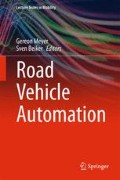Abstract
Road vehicle travel at a reasonable speed involves some risk, even when using computer-controlled driving with failure-free hardware and perfect sensing. A fully-automated vehicle must continuously decide how to allocate this risk without a human driver’s oversight. These are ethical decisions, particularly in instances where an automated vehicle cannot avoid crashing. In this chapter, I introduce the concept of moral behavior for an automated vehicle, argue the need for research in this area through responses to anticipated critiques, and discuss relevant applications from machine ethics and moral modeling research.
Access this chapter
Tax calculation will be finalised at checkout
Purchases are for personal use only
References
Fambro DB, Fitzpatrick K, Koppa RJ (1997) Determination of stopping sight distances. Transportation Research Board, Washington D.C, NCHRP 400
Fraichard T, Kuffner JJ (2012) Guaranteeing motion safety for robots. Auton Robots 32(3):173–175
Fraichard T, Asama H (2004) Inevitable collision states—a step towards safer robots? Adv Robot 18(10):1001–1024
Benenson R, Fraichard T, Parent M (2008) Achievable safety of driverless ground vehicles. In: 10th international conference on control, Automation, Robotics and Vision, ICARCV 2008, pp 515–521
Bautin A, Martinez-Gomez L, Fraichard T (2010) Inevitable collision states: a probabilistic perspective. In: 2010 IEEE international conference on robotics and automation (ICRA), pp 4022–4027
Ferguson DIF, Dolgov DA (2013) Modifying behavior of autonomous vehicle based on predicted behavior of other vehicles. US Patent Application 2,013,026,187,2 Kind Code: A1
Dingus TA, Klauer SG, Neale VL, Petersen A, Lee SE, Sudweeks J, Perez MA, Hankey J, Ramsey D, Gupta S, Bucher C, Doerzaph ZR, Jermeland J, Knipling RR (2006) The 100-car naturalistic driving study, phase II—results of the 100-car field experiment. Virginia Tech Transportation Institute, DOT HS 810 593
Najm WG, Sen B, Smith JD, Campbel BN (2003) Analysis of light vehicle crashes and pre-crash scenarios based on the 2000 general estimates system. National Highway Traffic Safety Administration, Washington DC, DOT-VNTSC-NHTSA-02-04
Foot P (1967) The problem of abortion and the doctrine of double effect. Oxf Rev 5:5–15
Templeton B (2013) Enough with the trolley problem, already. Brad Ideas, 10-Oct-2013. [Online]. Available: http://www.ideas.4brad.com/enough-trolley-problem-already. Accessed 11 Oct 2013
Bilger B (2013) Auto correct: has the self-driving car at last arrived? The New Yorker, 25-Nov-2013
John A Volpe National Transportation Systems Center (2008) Vehicle-infrastructure integration (VII) initiative benefit-cost analysis v.2.3 (draft), Federal Highway Administration, May 2008
National Highway Traffic Safety Administration (2013) Preliminary statement of policy concerning automated vehicles. National Highway Traffic Safety Administration, Washington DC, NHTSA 14-13
Llaneras RE, Salinger JA, Green CA (2013) Human factors issues associated with limited ability autonomous driving systems: drivers’ allocation of visual attention to the forward roadway. In: Proceedings of the seventh international driving symposium on human factors in driver assessment, training, and vehicle design, Bolton Landing, New York, pp 92–98
Jamson AH, Merat N, Carsten OMJ, Lai FCH (2013) Behavioural changes in drivers experiencing highly-automated vehicle control in varying traffic conditions. Transp Res Part C: Emerg Technol 30:116–125
American Association of State Highway and Transportation Officials (2011) A policy on geometric design of highways and streets, 6th ed. AASHTO, Washington, DC
Bosch (2009) LRR3: 3rd generation long-range radar sensor. Robert Bosch GmbH, Leonberg, Germany, 292000P03 W-C/SMC2-200906-En. http://www.bosch-automotivetechnology.com/media/db_application/downloads/pdf/safety_1/en_4/lrr3_datenblatt_de_2009.pdf. Accessed 15 Nov 2013
United States Census Bureau (2012) Statistical abstract of the United States. United States Census Bureau, Washington, DC, Table 1107. Vehicles Involved in Crashes by Vehicle Type, Rollover Occurrence, and Crash Severity: 2009
Lin P (2013) The ethics of autonomous cars. The Atlantic, 08-Oct-2013. [Online]. Available: http://www.theatlantic.com/technology/archive/2013/10/the-ethics-of-autonomous-cars/280360/. Accessed 09 Oct 2013
Goodall NJ (Forthcoming, 2014) Ethical decision making during automated vehicle crashes. Transp Res Rec: J Transp Res Board
Lin P (2013) The ethics of saving lives with autonomous cars are far murkier than you think. Wired Opinion, 30-Jul-2013. [Online]. Available: http://www.wired.com/opinion/2013/07/the-surprising-ethics-of-robot-cars/. Accessed 30 Jul 2013
Hibbard B (2012) Avoiding unintended AI behaviors. In: Artificial general intelligence: 5th international conference, Oxford, UK, pp 107–116
Beavers AF (2009) Between angels and animals: the question of robot ethics, or is Kantian moral agency desirable? In: Annual meeting of the association of practical and professional ethics, Cincinnati, OH
Powers TM (2006) Prospects for a Kantian machine. IEEE Intell Syst 21(4):46–51
Tonkens R (2009) A challenge for machine ethics. Mind Mach 19(3):421–438
Powers TM (2013) Prospects for a Smithian machine. In: Proceedings of the international association for computing and philosophy, College Park, Maryland
Powers TM (2005) Deontological machine ethics. In: Machine ethics: papers from the AAAI fall symposium, Menlo Park, CA: AAAI Press
Bringsjord S, Arkoudas K, Bello P (2006) Toward a general logicist methodology for engineering ethically correct robots. IEEE Intell Syst 21(4):38–44
Asimov I (1942) Runaround. Astounding Sci Fiction 29(1):94–103
Hansson SO (2007) Ethics and radiation protection. J Radiol Prot 27(2):147
Anderson M, Anderson SL, Armen C (2005) Towards machine ethics: implementing two action-based ethical theories. In: Proceedings of the AAAI 2005 fall symposium on machine ethics, Arlington, VA
Ross WD (1930) The right and the good. Oxford University Press, Oxford
Rawls J (1999) A theory of justice, rev. ed. Belknap Press of Harvard University Press, Cambridge
Anderson M, Anderson SL, Armen C (2006) MedEthEx: a prototype medical ethics advisor. In: Proceedings of the 18th conference on innovative applications of artificial intelligence, Boston, Massachusetts, vol 2, pp 1759–1765
Beauchamp TL, Childress JF (1979) Principles of biomedical ethics. Oxford University Press, New York
McLaren BM (2006) Computational models of ethical reasoning: challenges, initial steps, and future directions. IEEE Intell Syst 21(4):29–37
Reed GS, Jones N (2013) Toward modeling and automating ethical decision making: design, implementation, limitations, and responsibilities. Topoi 32(2):237–250
Author information
Authors and Affiliations
Corresponding author
Editor information
Editors and Affiliations
Rights and permissions
Copyright information
© 2014 Springer International Publishing Switzerland
About this chapter
Cite this chapter
Goodall, N.J. (2014). Machine Ethics and Automated Vehicles. In: Meyer, G., Beiker, S. (eds) Road Vehicle Automation. Lecture Notes in Mobility. Springer, Cham. https://doi.org/10.1007/978-3-319-05990-7_9
Download citation
DOI: https://doi.org/10.1007/978-3-319-05990-7_9
Publisher Name: Springer, Cham
Print ISBN: 978-3-319-05989-1
Online ISBN: 978-3-319-05990-7
eBook Packages: EngineeringEngineering (R0)

